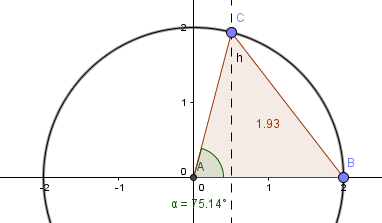What Is The Sandwiched Angle?
What is the largest possible area of an isosceles triangle with two sides of length 2?
This section requires Javascript.
You are seeing this because something didn't load right. We suggest you, (a) try
refreshing the page, (b) enabling javascript if it is disabled on your browser and,
finally, (c)
loading the
non-javascript version of this page
. We're sorry about the hassle.
6 solutions
Let △ A B C be an isosceles triangle with A B = A C = 2 and 0 < ∠ B A C < π then 0 < sin ∠ B A C ≤ 1
Using the sine rule to calculate the area of the triangle.
area ( △ A B C ) = 2 1 ⋅ A B ⋅ A C ⋅ sin ∠ B A C ≤ 2 1 ⋅ 2 ⋅ 2 ⋅ 1 = 2
So
a r e a ( △ A B C ) ≤ 2
Why did u do AB*AC and not AD * sinA
Sorry I understood
If we put the one of two sides with lengh = 2 as the base of the triangle, the other vertex is in a cercle of radius=2
and AREA = 2 * h / 2 (the maximum value of h is 2, the maximum area is 2 when the triangle is rectangle)

Nice method!
The area of triangle with sides a and b , subtending an angle of θ is 2 1 a b sin θ .
So the area of this triangle is 2 1 ( 2 ) ( 2 ) ( sin θ ) = 2 sin θ .
Since sin θ has a maximum of 1 , the maximum area is 2 .
Using Heron's formula for area of a triangle
A=√s(s-a)(s-b) (s-c), where a,b and c are three sides and
s=(a+b+c)/2 i. e. half the perimeter, we find in the instant case that a=b=2 and let the third side be 2x. Then s=(2+2+2x)/2,
s=(x+2). Therefore, area of triangle.
A=√(x+2)(x+2-2)(x+2-2)(x+2-2x)
=√x^2(4-x^2)
=√{4-(4-4x^2+x^4)=√{4-(2-x^2)^2}
Therefore, A will be maximum
when x^2-2=0 i. e. the third side is
2x=2√2, hypotenuse of the right triangle, and the maximum value of area will be A=√4=2.
note that area of this isosceles triangle is 2sin2x where x is the base angle and since max value sin2x can achieve is 1, the answer is 2
Area of triangle = 2 1 * sinθ * ab, here, a = 2, b = 2, max sinθ = sin90 = 1, Max area = 2